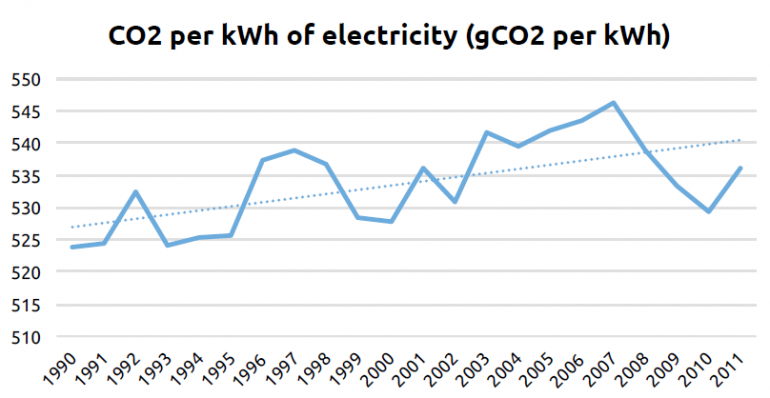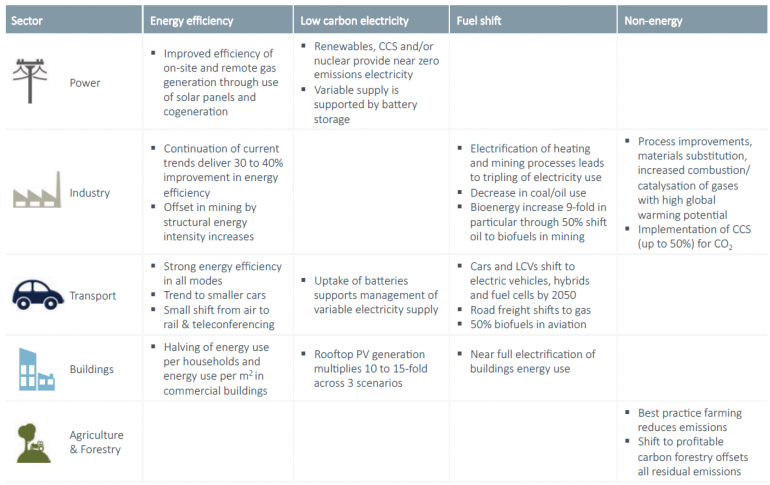Banishing the hippies from the energy-climate debate
Robert Bryce, a journalist that recently toured Australia promoting fossil fuel use – courtesy of the conservative think-tank the Institute of Public Affairs – made an interesting and worthwhile point during his trip:
Over a billion people live without electricity and another few billion live in energy poverty. You say CO2 is bad – OK, but what is your alternative to hydrocarbons?
When you look at the numbers, the task of replacing hydrocarbons/fossil fuels can seem insurmountable. While we’ve made incredible advancements with solar cells and wind turbines and an array of energy efficiency innovations, on a global basis it has barely made a dent in the use of fossil fuels. The latest data from the Climate Action Tracker shows that the carbon intensity of electricity supply on a global basis has got worse since 1990.

Source: Climate Action Tracker (2014) Policy Brief – September 22, 2014
But the thing is that a lot of those who are deeply concerned about the impacts of unconstrained CO2 emissions, know only too well about the overwhelming dominance of fossil fuels. They understand all the characteristics of these fuels that have made them so useful and difficult to replace. And they also know about the essential nature of ubiquitous, reliable, convenient and affordable energy in advancing the lives of humanity.
Indeed they know this better than most because a number of them have spent their professional lives worrying about how to answer Bryce’s exact question.
Just today we can see yet another instalment in the effort to address this question.
Recently (Pathways to a climate-contained, affluent 2050, July 9), I touched upon an international collaboration led by economist Jeffrey Sachs. This collaboration analysed how 15 of the globe’s biggest emitting nations could reduce emissions consistent with containing global warming to 2 degrees while still tripling economic output by 2050. Today they are releasing the underlying detailed analysis for how each country could potentially decarbonise – including Australia but also poorer nations such as India, China and Indonesia.
The Australian study was undertaken by a combination of researchers from the Australian National University, CSIRO, ClimateWorks and macroeconomic modellers at the Centre of Policy Studies, formerly of Monash University and now at Victoria University.
The interesting element to this study is that it shows there are, in fact, a multitude of technological options for how we might continue to grow our economy while dramatically lowering Australia’s emissions. One of these pathways involves Australia still making significant but reduced use of fossil fuels for electricity generation, but with the emissions captured and stored underground. Another makes use of nuclear power. A third relies almost entirely on renewable energy. But, according to the researchers, it makes economic sense in all cases to make significant use of renewable energy across all three pathways – as illustrated in the chart below.
Figure 2: Alternative options for a decarbonised electricity supply mix in Australia

Of course, if you don’t like renewable energy – maybe because you think it’s a hippy-thing that requires you to reject capitalism and join a commune to make use of it – in the scenarios above, then up the nuclear power. Or make greater use of fossil fuels with carbon capture and storage. Either way, there are technological options available to grow our economy while dramatically lowering emissions.
What about fossil fuel use and greenhouse gas emissions outside of electricity?
The table below summarises the improvements they’ve examined beyond just power supply.
Firstly, we actually need to make greater use of electricity in areas where direct combustion of fossil fuels currently dominates. The report outlines that we need to electrify transport and also heating and cooking applications in our homes and offices. In addition, it also looks at increasing the use of electricity in industrial and mining processes.
And of course the other element is enhancing energy efficiency and, importantly, also the efficiency with which we use energy- and carbon-intensive materials like metals and cement.
Figure 3: Modelled pathway for deep reductions in Australia’s emissions

Now, the really important point to remember is this is yet another study on top of several other studies that have taken on Bryce’s question and come to the same conclusion. They find we can have all the wonderful things that energy makes possible and dramatically reduce fossil fuel use and carbon emissions.
These studies start with the underlying physics and available resources, particularly the pioneering work of Mark Jacobson at Stanford University. This work demonstrates that the energy available globally from the sun and wind, and the raw materials required to effectively exploit this energy, are far greater than anything we could ever need.
Others, such as Mark Diesendorf and Clive Hamilton, made the initial examinations of the resources and technologies that could allow Australia to meet its energy needs while achieving deep cuts in emissions. This then improved in sophistication with dynamic energy and economic models applied by the likes of the Australian Treasury, the Centre of Policy Studies, CSIRO and McLennan Magasanik (now Jacobs-SKM).
It then went another step further by incorporating short-term weather variation data through the work of Matthew Wright, Patrick Hearps and their team at Beyond Zero Emissions. This was followed by another team of researchers at University of NSW led by Ben Elliston and involving Mark Diesendorf again, as well as Iain MacGill. It reached a pinnacle in its sophistication with the '100 per cent renewables' work of the Australian Energy Market Operator working in collaboration with ROAM Consulting and CSIRO to explore how electricity demand could be met hour-by-hour taking into account actual data on historical patterns of wind and solar energy across multiple geographical zones around Australia.
None of this work suggests the task of replacing fossil fuels is easy, but it does suggest it is achievable and affordable – all without having to retreat to a hippy commune that makes do with candles, firewood and – infrequent – cold showers.
















